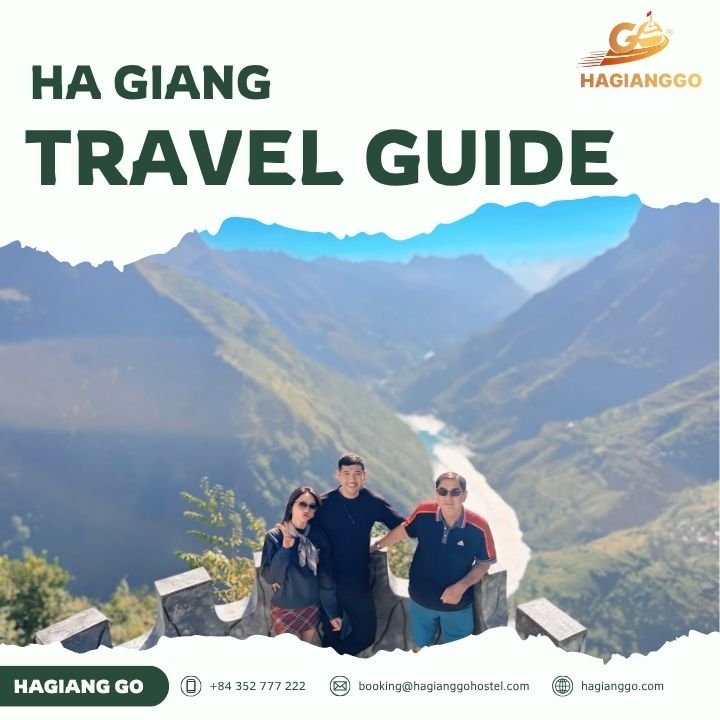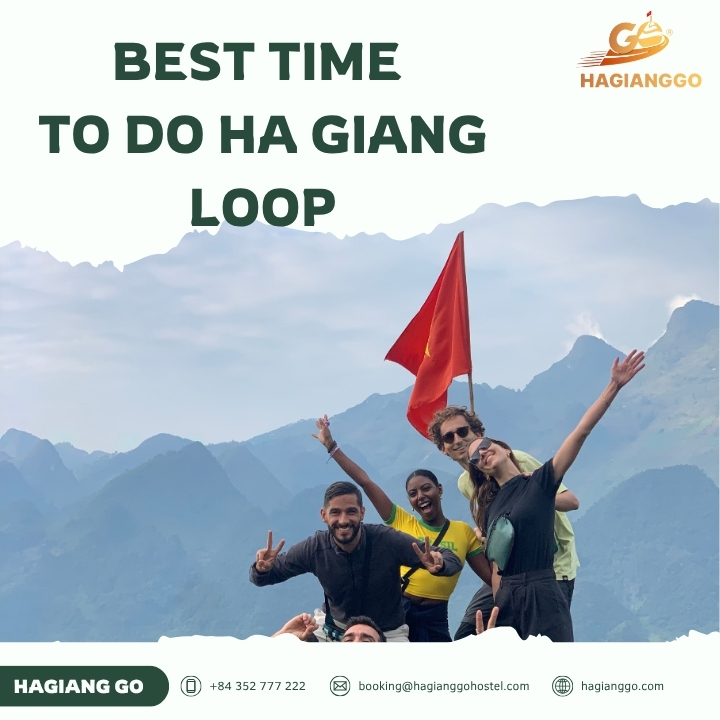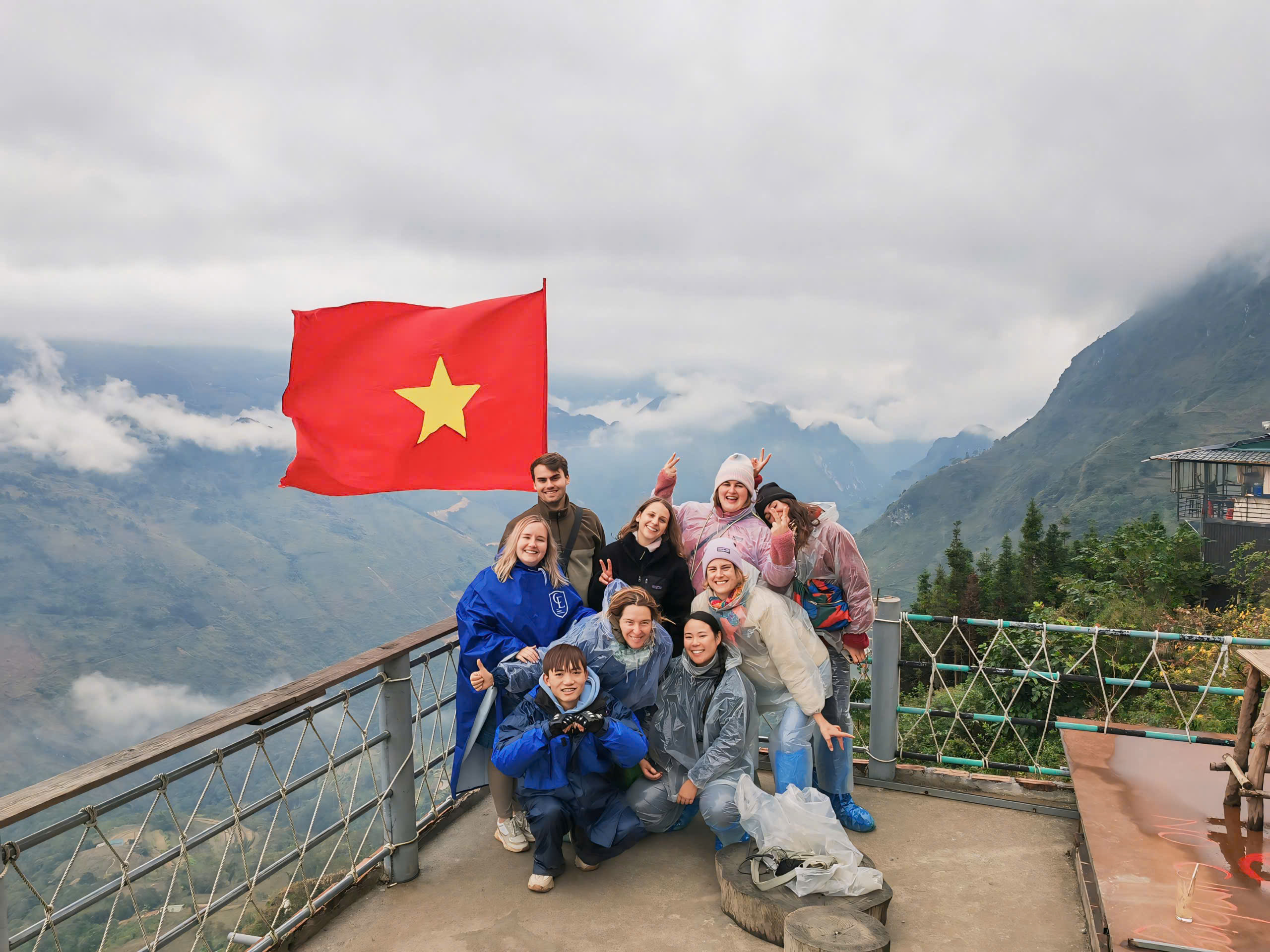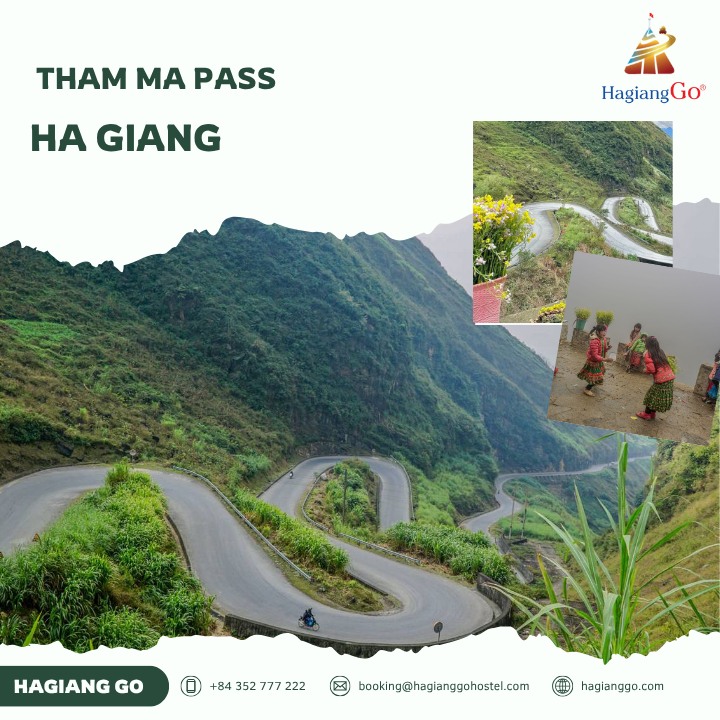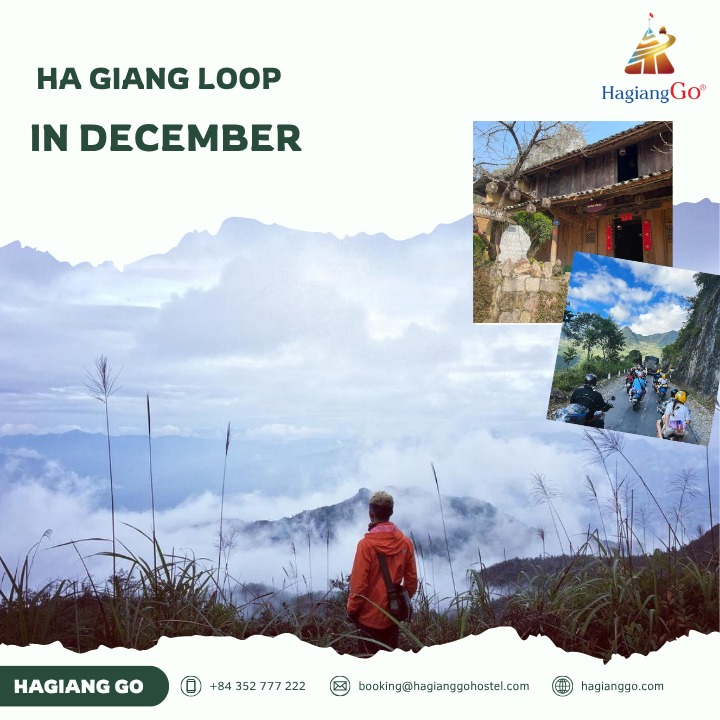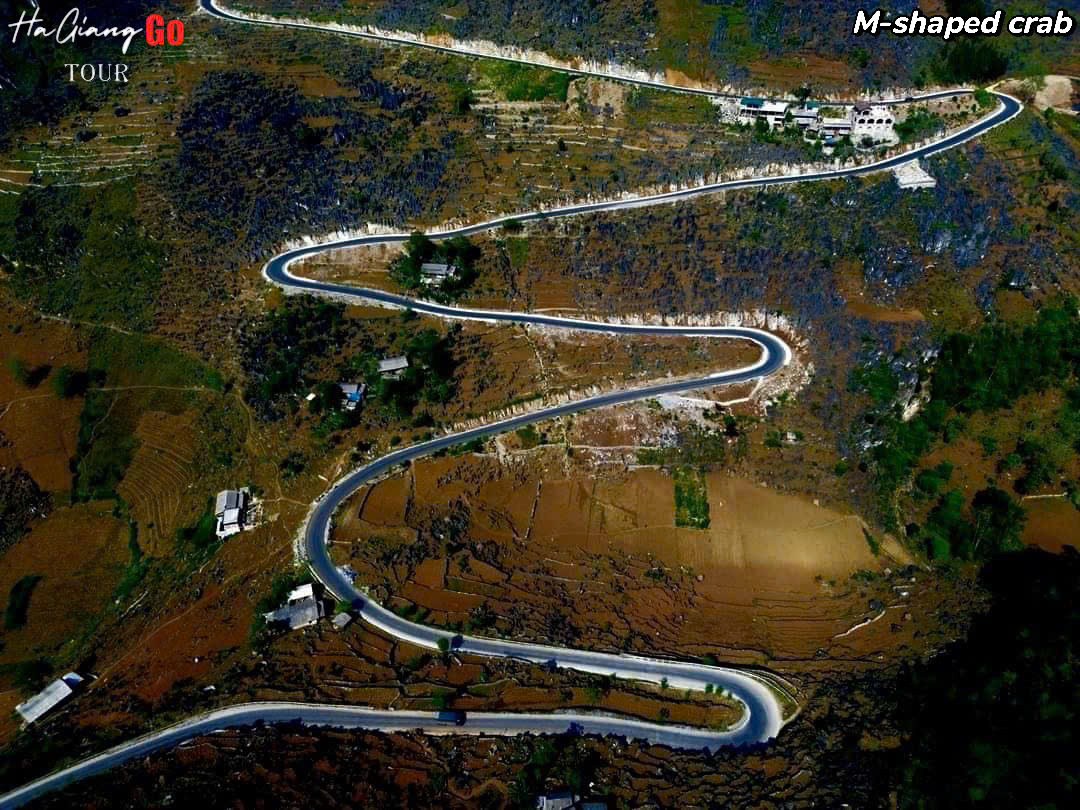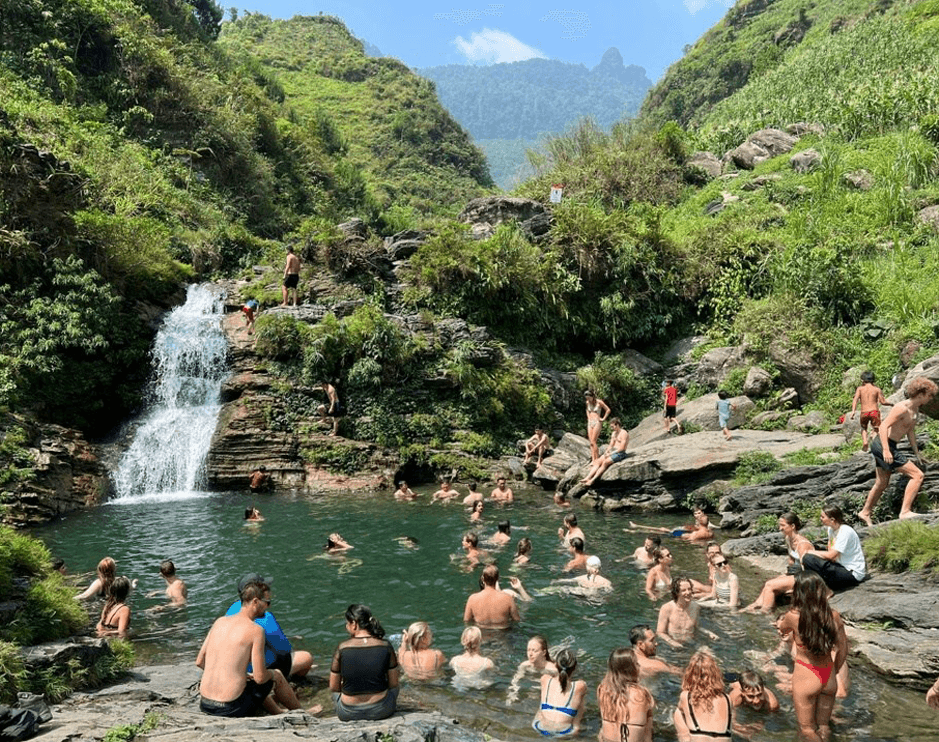Discover the ultimate Ha Giang travel guide for exploring Vietnam's most spectacular mountain province, featuring the legendary Ha Giang Loop, ethnic villages, and breathtaking landscapes.
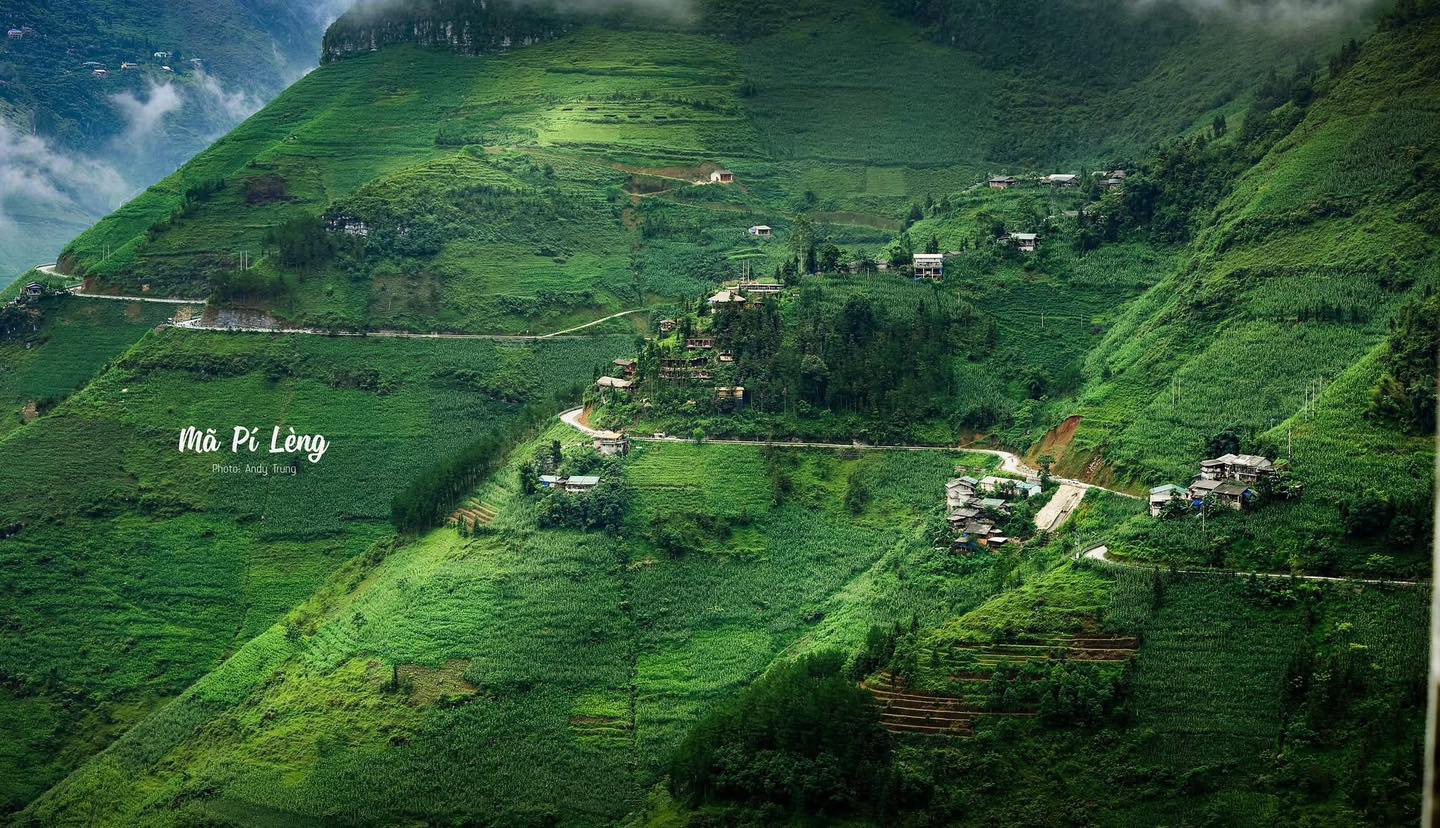
When is the best time to take a Ha Giang Loop
Ha Giang's climate is characterized by a tropical monsoon, featuring a rainy season from May to September or October, and a dry season from October or November to April.
Autumn (September-November): OPTIMAL
- Cool, dry weather (15-24°C)
- Golden rice terraces and clear mountain views
- Peak season with ethnic festivals
Spring (March-May): EXCELLENT
- Mild temperatures (15-28°C)
- Blooming peach/plum blossoms
- Lush green scenery, fewer crowds
Other Seasons:
- Late Autumn/Winter (Nov-Feb): Buckwheat flowers, misty mountains, cooler (5-23°C)
- Summer (June-Aug): Hot, humid (22-32°C), heavy rains, potential landslides
→ Recommendation: Dry season (October-April) offers the most predictable weather and safer road conditions, though mountain weather can change rapidly year-round.
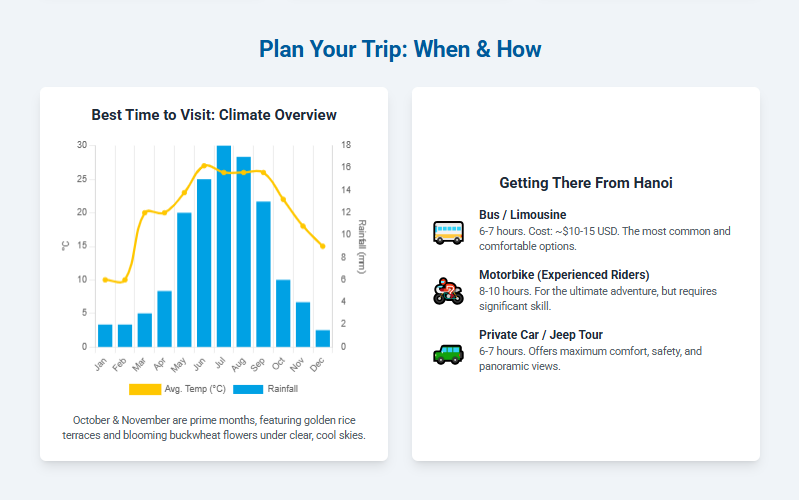
Ha Giang travel guide: How to get there?
Ha Giang is accessible from Hanoi through several transportation modes, catering to different preferences for comfort, cost, and adventure.
- By Bus: Daily bus services depart from My Dinh Bus Station in Hanoi. The journey typically spans approximately 6 to 7 hours, though travel time can vary based on road conditions. Ticket prices generally range from 250,000 to 350,000 VND, equivalent to about $10 to $15 USD.
- By Limousine Minivan: For those seeking a more comfortable travel experience, limousine minivans offer a comparable travel time of around 6 to 7 hours during the daytime. Some organized tour packages, including "Easy Rider" options, may incorporate luxury sleeper bus or limousine transfers as part of their inclusive services.
- By Motorbike: Experienced riders can embark on a thrilling motorbike journey directly from Hanoi. This option, while offering immense freedom and adventure, is a longer commitment, typically taking 8 to 10 hours and involving navigation through mountain roads.
- By Private Car: For a highly personalized and comfortable journey, private tours with an English-speaking guide and a dedicated driver are available, offering a tailored travel experience.
Best ways to discover this hidden gem
The Ha Giang Loop, a roughly 370-kilometer (230-mile) road trip through the Dong Van Karst Plateau, stands as the quintessential way to explore this remote province. While renowned for its breathtaking beauty, the loop also presents significant challenges due to its narrow, steep, and often unpredictable roads, characterized by sharp turns, sudden drops, and the potential for occasional landslides.
Travelers have several options for navigating this challenging yet rewarding route:
Easy Rider with a tour
are the most recommended option for exploring Ha Giang, especially for inexperienced riders or those seeking a safer, more relaxed journey. Local drivers provide expert navigation, road safety, and cultural insights while bridging language barriers.
What's Included:
- Experienced English-speaking guides
- Quality motorcycles and fuel
- Protective gear (helmets, pads, rain clothes)
- Meals and accommodation (homestays to hotels)
- Entrance tickets and travel permits
Key Benefits:
- Safety: Expert handling of challenging terrain and weather conditions
- Cultural Immersion: Local drivers share intimate regional knowledge
- Convenience: All logistics handled, from 2-7 day packages
- Accessibility: Makes Ha Giang accessible to all skill levels
→ Why Choose Easy Rider: This isn't just transportation—it's a comprehensive solution that transforms Ha Giang's challenging terrain from an obstacle into an opportunity for deeper cultural engagement while ensuring traveler safety and supporting local economies.
Self-riding with a rental motorbike
For seasoned motorcyclists, undertaking the loop independently on a motorbike offers unparalleled freedom and a profound sense of adventure. However, this choice demands considerable respect for the terrain, thorough preparation, and a high degree of caution, particularly for novice riders, given the inherent difficulties of the roads. It is imperative for self-riders to carry a valid driver's license from their home country along with an International Driving Permit (IDP), as police checkpoints are a common occurrence along the route.
Car/Jeep Tours
For those who prefer not to ride motorbikes, open-air Jeep tours offer an exceptional way to experience the Ha Giang Loop. These tours provide comfort and safety while allowing passengers to fully appreciate the panoramic views. Private car tours originating from Hanoi are also an option for a more personalized travel experience.
The Legendary Ha Giang Loop Guide To Discover
Understanding the Loop
The Ha Giang Loop is an approximately 370-kilometer (230-mile) road trip that winds through the majestic Dong Van Karst Plateau. While it is flexible enough to be completed in anywhere from 3 to 10 days, a typical and popular duration for this journey is four days. The loop encompasses over 300 kilometers of breathtaking scenery, transitioning from expansive terraced rice fields to towering limestone mountains. It is important to acknowledge that the roads are known for being narrow, steep, and often unpredictable, featuring sharp turns, sudden drops, and the potential for occasional landslides. Therefore, meticulous planning of an itinerary is crucial to ensure that iconic attractions are not missed and that daily driving distances are managed effectively.
Suggested Ha Giang Loop travel itineraries
The following itineraries provide structured options for experiencing the Ha Giang Loop, catering to different time constraints and desired levels of exploration.
The 3-Day Adventure: Highlights for the Time-Conscious Traveler
This condensed itinerary covers primary highlights but involves longer daily driving periods.
- Day 1: Ha Giang City to Yên Minh. Journey north, ascending Bac Sum Pass and passing through Quan Ba Pass (Heaven Gate) for initial scenic views.
- Day 2: Yên Minh to Dong Van to Mèo Vạc. Continue through Dong Van's Old Quarter, then proceed to Mèo Vạc, encompassing iconic sections like Ma Pi Leng Pass and the Nho Que River.
- Day 3: Mèo Vạc to Ha Giang City. Conclude the loop with the return journey, potentially including Lung Cu Flag Tower and Tham Ma Pass.
The Classic 4-Day Journey: A Balanced Exploration
Widely considered ideal for first-time visitors, this itinerary offers a balanced pace for comprehensive exploration.
- Day 1: Ha Giang City to Quan Ba. (Approx. 50 km) Ascend Bac Sum Pass and Quan Ba Pass (Heaven Gate), enjoying views of the Twin Mountains. Overnight in a local homestay.
- Day 2: Quan Ba to Yên Minh to Dong Van. (Approx. 100 km) Visit Yên Minh Pine Forest, Dong Van Karst Plateau Geopark, Vuong Palace, and Lung Cu Flag Tower. Explore Dong Van Old Quarter. Overnight in Dong Van.
- Day 3: Dong Van to Ma Pi Leng Pass to Mèo Vạc. (Approx. 80 km) Conquer Ma Pi Leng Pass for breathtaking views of the Nho Que River, with an optional boat ride. Visit the Happiness Road Museum. Overnight in Mèo Vạc.
- Day 4: Mèo Vạc to Ha Giang City. (Approx. 150 km) Ride through Tham Ma Pass and return to Ha Giang City, with time to explore the city center.
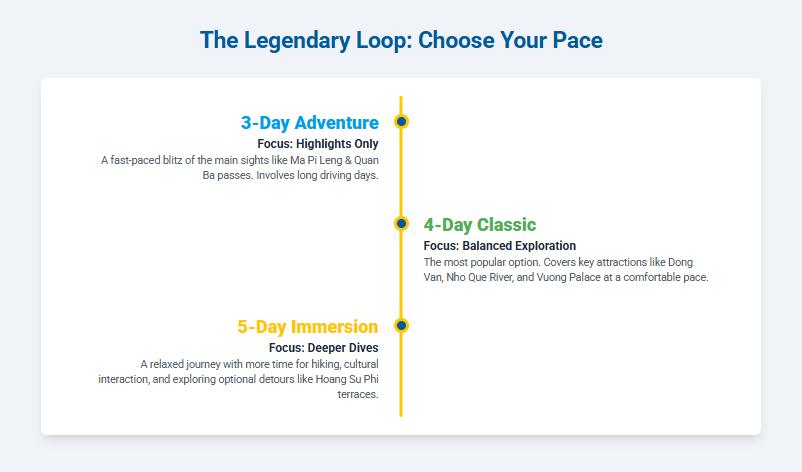
The Extended 5-Day Immersion: Deeper Dives and Relaxation
This itinerary allows more time for exploration, cultural activities, and can include the Hoàng Su Phì rice terraces.
- Option 1 (Loop-focused): A more leisurely pace through the classic loop.
- Day 1: Ha Giang City to Quan Ba.
- Day 2: Quan Ba to Yên Minh.
- Day 3: Yên Minh to Dong Van.
- Day 4: Dong Van to Mèo Vạc.
- Day 5: Mèo Vạc to Ha Giang City.
- Option 2 (Hoàng Su Phì focus): Highlights the terraced rice fields.
- Day 1: Hanoi to Hoàng Su Phì Rice Terraces.
- Day 2: Hoàng Su Phì - Trekking to Nam Khoa Village and Yao Village.
- Day 3: Hoàng Su Phì to Dong Van to Yên Minh (via Sky Gate, Twin Mountains, Sủng Là, Hmong King's Palace).
- Day 4: Dong Van to Mèo Vạc to Ha Giang.
- Day 5: Ha Giang to Hanoi.
Choosing an itinerary involves balancing seeing main scenic points with achieving deeper cultural immersion. Shorter trips prioritize speed, while longer trips offer a richer experience of Ha Giang's diverse landscape and cultures.
Must-See Attractions and Experiences
Ha Giang is replete with natural wonders, historical sites, and vibrant cultural experiences that captivate every traveler.
Iconic natural spots to visit in Ha Giang
The province is renowned for its dramatic mountain passes, offering some of Vietnam's most spectacular vistas:
- Ma Pi Leng Pass: Often referred to as the “King of Passes,” this approximately 20-kilometer section of road provides breathtaking, panoramic views of towering limestone cliffs, intricate twisty switchbacks, and the emerald Nho Que River winding through the valley below. It is an exceptional spot for photography, particularly during sunrise or sunset when the light casts a magical glow.
- Quan Ba Pass (Heaven Gate): Located about 45 kilometers from Ha Giang city, this pass, at an elevation of 1,945.8 meters, offers stunning views of the Quản Bạ Valley and the distinctive, uniformly shaped hills known as Thach Nui Doi, or "Two Stone Breasts". Cafe Cong Troi is a popular lookout point for visitors.
- Bac Sum Pass: This 7-kilometer section is known for its challenging switchbacks, providing an exhilarating ascent coupled with highly scenic views.
- Tham Ma Pass: A picturesque mountain pass distinguished by its iconic "S" shaped road, offering stunning vistas of terraced rice fields and valleys.
- Nho Que River & Tu San Canyon: Originating from the mountains, the emerald-green Nho Que River carves its way through steep valleys and lush landscapes, revealing the geological wonders of the Tu San Canyon, which is recognized as Vietnam's deepest gorge. Exploring the river by boat, kayak, or self-rowing boat is a highly recommended activity, offering unique perspectives of the dramatic cliffs. The H'Mong, Tày, and other ethnic villages situated along its banks add a rich cultural dimension to the scenic beauty. Top best things to experience here include: motorboat riding & self-rowing boat riding, and kayaking
- Dong Van Karst Plateau Geopark: Designated as a UNESCO Global Geopark, this expansive area is defined by its majestic limestone peaks, deep valleys, and cloud-shrouded summits. Driving along its winding mountain roads is an exhilarating experience, with routes like the Ma Pi Leng Pass offering incredible views. The geopark represents a harmonious blend of nature and humanity, showcasing how ethnic communities have adapted their lives within this unique geological terrain.
- Du Gia Waterfall: Located just outside the main Du Gia village, this pleasant swimming hole and sundowner spot is ideal for a refreshing dip after a day of exploration.
- Hoang Su Phi Rice Terraces: These vast, intricately arranged rice fields, sculpted into the mountain slopes, are a must-see. They are particularly stunning in autumn (September-October) when they glow with a golden hue just before harvest. Walking through these terraces offers a sensory experience, enhanced by the subtle aroma of ripened rice.
- Sung La Valley: This valley is celebrated for its enchanting flower gardens, especially during the buckwheat flower season (November-December), which draws numerous visitors.
- Noong Lake: Approximately 15 kilometers from Ha Giang City, this natural lake offers wild scenery, with a stream flowing along the base of the green Noong mountain.
- Phương Thiện Cave, Doi, Lang Lô, and Chui Cave: These natural caves and grottoes, situated south of Ha Giang city, provide opportunities for underground exploration. Tiên Cave, merely 2 kilometers from Ha Giang city, holds cultural significance as a water source and a place for traditional prayers.
- Twin Mountains (Nui Doi): A natural masterpiece near Quan Ba, these two perfectly rounded twin hills form a unique and captivating natural tableau.

Historical & Cultural Landmarks
Ha Giang's rich history and diverse cultural heritage are evident in its significant landmarks:
- Lung Cu Flag Tower: Positioned at Vietnam's northernmost point, this tower stands as a proud national symbol within the Dong Van Karst Plateau Geopark. Visitors can ascend its steps for sweeping panoramic views of the surrounding landscape.
- Vuong Palace (Hmong King's Palace): This grand mansion, constructed in 1914 by the French for a local Hmong king, offers a fascinating glimpse into colonial-era history and ancient architecture. Having survived major conflicts, it stands as a testament to past glory.
- Dong Van Old Quarter: A charming historical relic, this area features traditional clay houses and narrow cobblestone streets, perfect for a leisurely stroll. It is an integral part of the Dong Van Karst Plateau Geopark.
Engaging with Local Culture: Ethnic Villages and Vibrant Markets
Ha Giang is home to an extraordinary diversity of 16 distinct ethnic groups, with the H'mong constituting the largest population (32%), followed by the Tay (25%), and significant communities of Kinh, Nung, and Dao peoples.
- Ethnic villages: Visiting villages such as Lolo Chai, Then Pa, Sa Phin, Nam Khoa, and Yao provides travelers with unique opportunities to interact with locals, learn about ancestral customs, and even participate in daily routines like planting corn or weaving traditional fabrics. The Lung Tam Weaving Village, in particular, offers a chance to observe and even try traditional Hmong weaving techniques.
- Vibrant markets: These weekly markets are far more than mere trading posts; they are dynamic cultural crossroads. Serving as central hubs, they bring together various ethnic groups in a symphony of colors and sounds. Stalls are laden with local treasures, including freshly harvested agricultural products, traditional crafts, intricately patterned textiles, and medicinal herbs. Markets are typically most lively in the early morning, usually from dawn until around 10 a.m..
The appeal of Ha Giang is not solely its natural beauty, nor exclusively its rich cultural heritage, but rather the synergistic relationship between the two. The distinctive landscape has profoundly shaped the cultures and livelihoods of its ethnic groups, and these cultures, in turn, have adapted to and, in some cases, transformed the landscape, as exemplified by the terraced fields. Responsible tourism, when thoughtfully managed, provides economic incentives for these communities to sustain their traditional practices and preserve their cultural heritage. This creates a self-reinforcing cycle where the natural and cultural assets mutually enhance each other's value for both local inhabitants and visitors. This dynamic means that visitors are not merely observers but active participants in maintaining this delicate balance.
Accommodation & Culinary Delights
Where to stay
Ha Giang offers a diverse array of accommodation options designed to cater to various preferences and budgets:
- Hotels: Range from luxury options like Four Points By Sheraton Ha Giang (5-star, $40-43/night) to budget-friendly motels starting at $11-12/night.
- Homestays (Highly Recommended): Family-run establishments offering complete cultural immersion. Popular choices include Dong Que Homestay-Tours-Motorbike, An Home Ha Giang, and Ha Giang Creekside Homestay. Village-specific options include Nam Dam Village (Dzao settlement), Lolo Village homestays, and Auberge de Veo Mac (restored Hmong house).
→ It is advisable to book accommodations in advance, especially during peak tourist seasons. When staying in more remote and authentic homestays, travelers should consider bringing their own toiletries and towels, as these amenities may not always be provided.
Must-try local dishes in Ha Giang
Ha Giang's culinary scene is a rich convergence of diverse flavors, reflecting the ingenuity and deeply rooted traditions of its 19 distinct ethnic groups. The culinary traditions of Ha Giang are more than just about flavors; they are a testament to the resourcefulness and resilience of its ethnic communities in adapting to a challenging mountainous environment. Experiencing these unique dishes offers travelers a profound understanding of the local people's history, their intrinsic connection to the land, and the enduring nature of their cultural identity.

Here are the top 6+ must try foods in Ha Giang:
- Thang Co: This traditional Hmong "meat soup" was originally prepared with horse meat, but to cater to tourists, it now often incorporates buffalo, cow, or pork. The essence of Thang Co lies in its distinctive broth, simmered from bones and organs and infused with 12 typical spices, including star anise, cardamom, and lemon leaves. It is commonly enjoyed with "Men men" (steamed cornmeal), grilled corn cakes, and corn wine. The Dong Van Market, held on Sundays, is an ideal place to experience this authentic dish.
- Au Tau Porridge: Known locally as "bitter porridge," this unique dish utilizes au tau tubers, which are naturally poisonous but are safely processed by the Hmong people to become a regional specialty. It offers a distinctive bitter taste, balanced by the aroma of pork and spices, and is often served with minced lean meat, salt, pepper, and scallions. Considered nutritious, it is believed to help with colds and joint pain, and is often recommended for consumption at night to promote deeper sleep.
- Buckwheat Flower Cake: A particular delicacy during the buckwheat flower season (October to December), this cake is made from ground buckwheat grains, sugar, water, and sometimes a touch of rice flour, then steamed to create a fragrant, slightly sweet, soft, and spongy treat. Beyond cakes, buckwheat is also used to produce pho, beer, noodles, and wine in the region.
- Five-Colored Glutinous Rice: This visually appealing and culturally significant dish is served as a dessert during special occasions such as festivals and Lunar New Year celebrations. Its vibrant colors—purple, red, green, yellow, and blue—are derived from natural ingredients and symbolize the five basic elements (wood, fire, earth, metal, and water) in the Yin and Yang philosophy.
- Hunchback Chung Cake: A famous dish of the Red Dao people, this cake is prepared with upland sticky rice, small green beans, locally raised black pork, and wrapped in galangal leaves. It is then boiled for an extended period of 8-10 hours over traditional wood stoves.
- Other Local Delicacies: The local cuisine also includes leaf-fermented corn wine, grilled stone moss, various sausages, Dong Van steamed rice rolls (including egg versions), Bac Me bamboo-tube rice, dried buffalo meat, sour pho, corn pho, and thang den (stuffed sticky rice balls).
Local markets are excellent venues for sampling street food and engaging directly with local vendors. Many organized tours often include meals that feature fresh, locally sourced ingredients, providing an authentic taste of the region.
Essential Travel Tips for a Safe and Respectful Trip
To ensure a safe, enjoyable, and culturally sensitive journey through Ha Giang, travelers should consider the following essential tips.
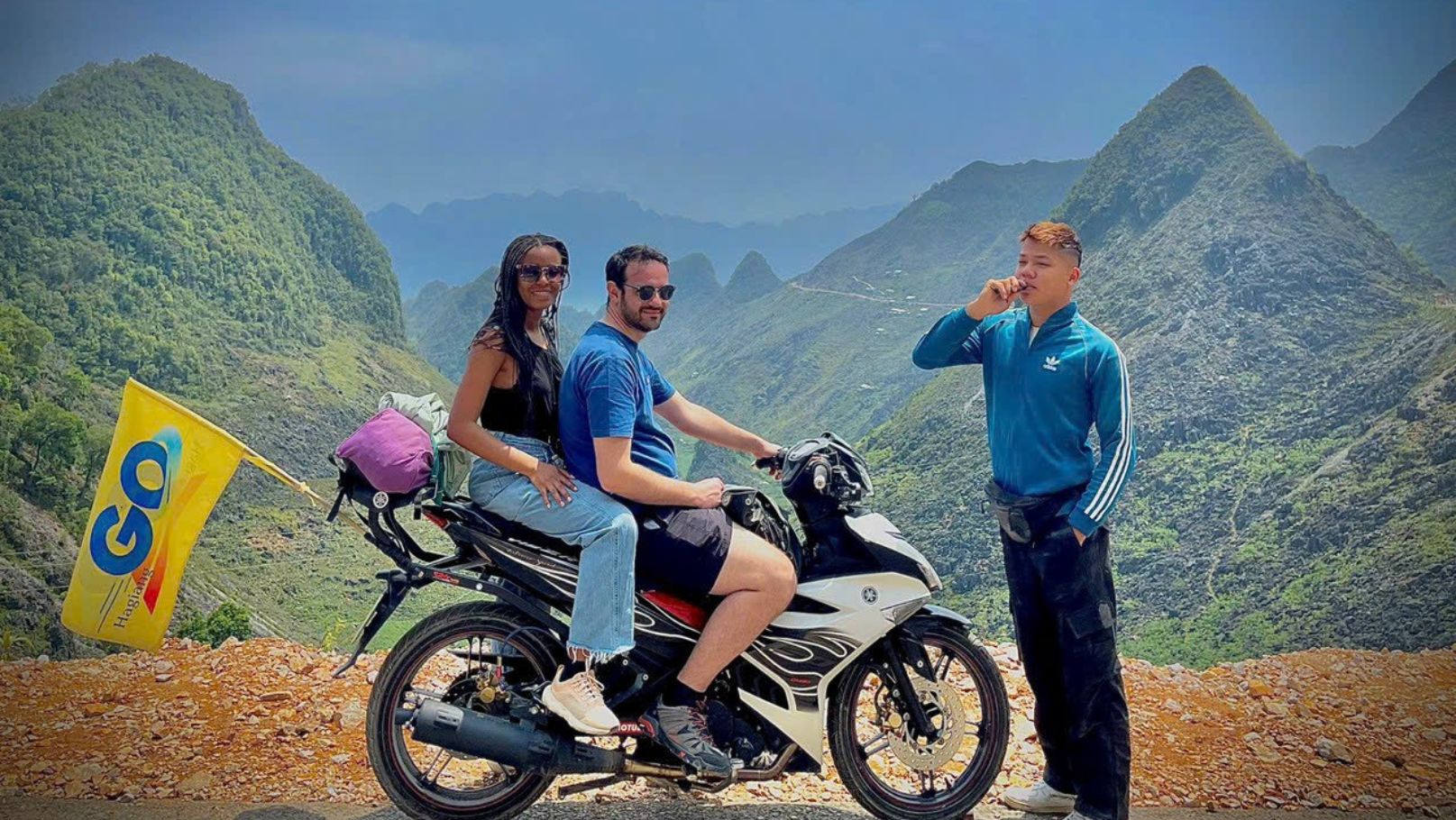
Riding in Ha Giang travel tips
Ha Giang Loop roads are challenging, with steep, winding, and unpredictable sections, and potential for landslides. Avoid riding at night due to poor visibility.
- Protective Gear: Always wear a well-fitting helmet, sturdy jacket, pants, waterproof boots, and gloves. Knee and elbow pads are also advisable. These are typically provided by rental shops or tours.
- Riding Practices: Ride cautiously, especially on sharp turns and descents. Maintain safe speeds and take regular breaks. Novice riders should practice on easier routes first.
- Weather: Mountain weather is unpredictable; pack layers and waterproof clothing for sudden storms, which can cause landslides.
- Insurance: Comprehensive travel insurance, covering emergency medical care and evacuation, is highly recommended, especially for motorbike riders.
- Documentation: Carry a valid driver's license and an International Driving Permit (IDP), as police checkpoints are common.
Packing Essentials: What to Bring for Mountain Adventures
Strategic packing is key for comfort and safety in Ha Giang's varied conditions:
- Clothing: Dress in layers to adapt to rapid temperature changes. Include light, breathable clothes for warmth and long clothes for sun/abrasion protection. A lightweight windbreaker or rain jacket is essential for unexpected rain and cold winds. Waterproof bags are vital.
- Footwear: Comfortable, closed walking shoes are necessary for exploring villages, hiking, and operating motorbike foot brakes.
- Health & Hygiene: Bring personal toiletries, a towel (as remote homestays may not provide them), necessary medications, and a basic first aid kit. Stay hydrated to prevent altitude sickness.
- Electronics & Connectivity: Carry a power bank for charging devices, a flashlight for night visibility, and a local SIM card (Viettel/Mobifone recommended for best coverage). Sunglasses are important for eye protection.
- Miscellaneous: Carry sufficient Vietnamese Dong (cash) as cards are rarely accepted in remote areas and ATMs are scarce outside Ha Giang City. Snacks and water are important for energy. A small day backpack is useful for essentials, with main luggage securely strapped to the motorbike.
Cultural Etiquette: Interacting with Local Communities
Ha Giang's ethnic groups have rich traditions; showing respect enhances your experience.
- Photography: Always ask explicit permission before photographing individuals or private property. This can lead to deeper cultural exchanges.
- Dress: Opt for modest attire to show deference to local customs.
- Behavior: Greet locals with a smile, use polite language, and be mindful of your demeanor. Tread gently in rice fields, as they are vital for livelihoods.
- Patience: Life moves at a different pace; patience and genuine interest can lead to profound connections.
- Markets: Bargain politely. Engage with vendors to learn about local traditions.
Navigating the Language Barrier: Tips for Communication
While some locals in tourism may speak English, learning basic Vietnamese phrases (e.g., "hello," "thank you") is greatly appreciated.
- Tools: Use a phrasebook or translation apps for deeper communication.
- Speaking: Speak simply and slowly, rather than loudly, to non-native English speakers.
- Visuals: Use hand gestures or visual aids to convey needs.
- Easy Riders: Guides are invaluable for bridging language barriers and enhancing cultural immersion.
Permits and Other Practicalities
- Travel Permit: Foreign tourists need a permit for certain border areas of Ha Giang. These can be obtained in Ha Giang City, often with assistance from hotels or rental shops. Arrange this in advance.
- Cash: Carry sufficient Vietnamese Dong (VND) as many remote villages are cash-only, and ATMs are limited.
- Booking: Book accommodations in advance, especially during peak seasons.
- Responsible Tourism: Support local social businesses like the Thôn Tha Responsible Tourism Cooperative. This helps reduce poverty, create sustainable jobs, and preserve cultural values, benefiting both locals and travelers.
Conclusion
Ha Giang offers an unparalleled adventure in Vietnam's northern frontier, blending majestic landscapes with rich cultural heritage. Its dramatic terrain, once an agricultural challenge, now fuels a thriving tourism industry, directly benefiting local ethnic communities.
Whether opting for a self-ride or the highly recommended "Easy Rider" service, the loop provides access to breathtaking sites like Ma Pi Leng Pass and the Nho Que River, alongside vibrant markets and authentic ethnic villages. Responsible tourism, emphasizing safety, cultural respect, and support for local initiatives, ensures a fulfilling experience that contributes to the region's sustainable development and cultural preservation.
